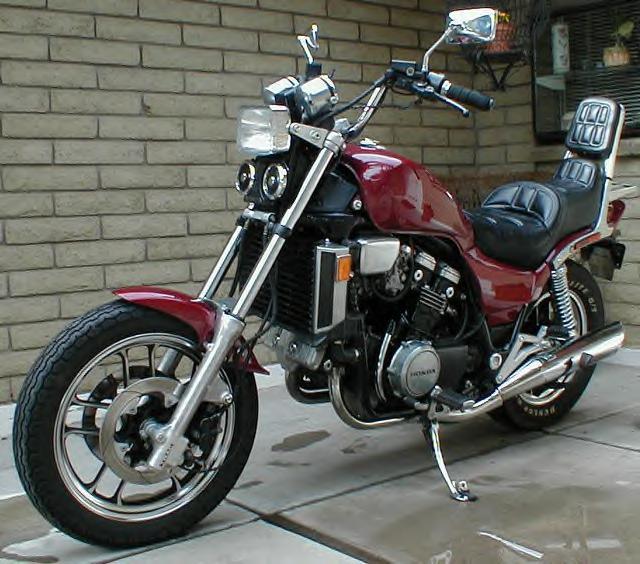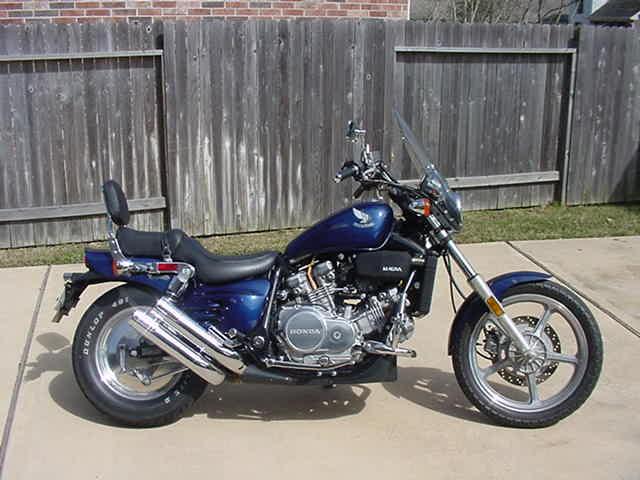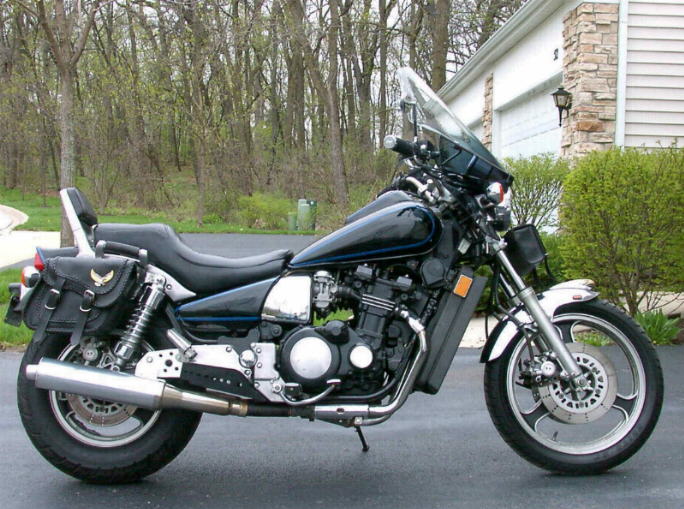


By any measure, the decade of the 1980's was a significant one for those in motorcycling. Motorcycling as a sport was proliferating, fed by the large numbers of low-priced, user friendly Japanese bikes on the market. Another contributing factor to the motorcycle boom of the late '70s was the second great fuel embargo cause by the Iranian revolution in 1979, which again caused gas prices to skyrocket and made more fuel-efficient motorcycles attractive to the frugal buyer.
To capitalize on what looked like a rich and growing market, motorcycle makers, particularly the Japanese, began to depart significantly from the designs that had seen them through the explosive growth years of the '60s and '70s. Those bikes had been relatively simple, air-cooled machines. By 1980, though, it appeared that even the venerable UJM, which had dominated both performance and big-bike sales in the '70s, had been taken to its limit of performance and style. To get more power, as well as a unique style that would set their products apart from the competition, manufacturers started experimenting with water cooling and with new engine configurations. Of course, water cooled motorcycles were available during the '70's, most notably in the Suzuki GT-series of 2-stroke bikes (nicknamed "water buffaloes") and in the Honda Gold Wing, introduced in 1975, but it wasn't until the '80s that water cooling became a staple on mid- and large-sized motorcycles (and even many off-road bikes switched to water cooling.)
Water cooling offers several advantages for an engine design. Water cooled motors operate in a narrower temperature range. Because of this, working parts can be made to a tighter tolerance, since the engineers don't have allow as much space for expansion and contraction. A properly maintained water-cooled motor also runs cooler than one that is air-cooled, which means the engine can run at higher RPMs for a longer period of time, thus generating more horsepower out of the same bore and stroke, and of course increasing the life and the durability of the engine.
As is always the case in engineering, there is a trade-off: The greater power and longevity comes at the expense of a heavier, more complex and more expensive machine. The motorcycle now has things like a radiator, fan, water pump and cooling jacket which can break or operate inefficiently, harming the performance of the bike or leaving the rider stranded by the side of the road. A leaking radiator could even potentially cause a serious wreck as the bike lays its own "slick" causing the rider to lose traction and crash. Nevertheless, the manufacturers bet that buyers would accept the tradeoff and they were largely correct.
Another factor that characterized many '80s bikes was the proliferation of shaft-drive as opposed to chain drive. Shaft drive was nothing new to motorcycling, of course. BMW had been making shaft-driven bikes for nearly half a century by this time (and even Harley Davidson made a shaft-driven bike during World War II!) By the late '70s, shaft driven bikes were available from all of the Japanese "big 4", as well as Moto Guzzi, and of course, BMW.
For the '80's bikes, though, at least at first it seemed as though shaft drive would be the rule rather than the exception. Even "performance-oriented" bikes like the Honda Sabre, Yamaha Seca, Suzuki VX-800 and the short-lived Yamaha Vision (a water-cooled, 550cc V-twin sport bike) were shaft-driven bikes.
A final major characteristic of many '80s bikes was a plethora of new engine configurations, including both air- and water-cooled inline sixes (the Honda CBX and Kawasaki KZ 1300, respectively) and a number of different V-twin and V-4 designs. As with water cooling, this was an attempt to get more performance out of the same sized engines, and in the case of the v-twins, to make a motorcycle that could finally compete directly with Harley Davidson in terms of look, sound and feel.
An interesting aspect of many of the 80's bikes was that they unashamedly used many of the most modern, high-technology features available at the time, including electronic instruments with rudimentary computers and LCD displays, triple-disk brakes and 6-speed transmissions. Although these features still exist on motorcycles today, they rarely are all found on the same platform. In the 80's, the Japanese manufacturers just naturally assumed that all motorcycle riders would want these high-tech features, even those who were riding "cruiser" styled bikes.
By the late '80s, the bottom had dropped out of the motorcycle market and manufacturers, especially the Japanese, were looking to cut corners wherever they could. They started by dropping models with marginal sales records, and, realizing that motorcycling had divided up into highly specialized cliques, started making more specialized bikes for each one. Models were introduced with only those features the manufacturers thought neccessary for that particular market, and "standard" motorcycles not targeted at a specific "niche market" almost disappeared entirely. In the cruiser market, particularly, where the steadily rising sales of Harley Davidson bikes demonstrated that most buyers would choose style and sound over performance and technology, the Japanese makers started cutting corners on instruments, brakes, and drive systems.
So this is my tribute to the 1980's Japanese motorcycle. It was the last time that Honda, Kawasaki, Suzuki and Yamaha would try to make a "do-everything" bike, or pile all of their high-tech goodies onto every bike they made. Even if there is another motorcycle "boom" period, it is unlikely that we will every see machines as eclectic and versatile as the bikes of the '80's.
Without further ado, then, here is my list of favorite '80's bikes, in alphabetical order by manufacturer, not in any particular order of preference.
Honda V45 and V-65 Magna (1982-1986)

1986 V-65 Magna
The Magna, introduced with great fanfare in 1982, was the first of the really radical '80s cruisers, introduced as a 750 in that year (the V45) and as an 1100 in 1983 (the V65) (the "45" and "65" indicated the engine size in cubic inches, as opposed to CC's, and also indicated Honda's desire to challenge Harley Davidson, which had always measured its engines in cubic inches.)
The Magnas and their sister bikes, the sport-touring V45 and V65 Sabres, incorporated all of the "80's bike" features previously mentioned: A water-cooled, 90-degree V-4 engine, shaft-drive, and a 6-speed transmission. The V-65 Magna was a true hot-rod bike, which even appeared for several years in the Guiness book of world records as the "fastest production motorcycle" with a top speed of over 160mph (270kph.) The "first generation" Magna was also among the most numerously produced of the early '80's bikes and used models are widely available in the second-hand motorcycle market.
Honda "Super Magna" (1987-1988)

the 1987 "Super Magna", was a 700cc bike
Honda discontinued the 1st generation of Magnas after 1986. The entry-level V30 and the awesome V65 Magnas were history, as was the Magna's sister bike, the sport-touring Sabre. In 1987, though, they introduced an all new, completely redesigned 2nd generation V45 Magna, sometimes called the "Super Magna." Where the 1st generation Magnas had the typically awkward Japanese cruiser styling so common to '80s bikes, the Super Magna was a stunningly bold and innovative design. With its new raked-out fork, upswept double chrome exhausts on either side, solid disc aluminum rear wheel, and (on some models) a blacked-out, non-finned engine, a Super Magna could not be mistaken for anything else on the road.
In terms of engineering, the Super Magna retained the shaft-drive and 6-speed transmission of its predecessor, but was reduced to a single, rather than a double, front disk brake. (Interestingly, and somewhat depressingly, IMO, the modern, 3rd generation Magna lacks both the shaft and the 6-speed.)

Another 87, this one with the optional passenger seat and backrest
Unfortunately, by 1987 when the Super Magna was introduced, it seemed that most "cruiser" buyers wanted something more Harley-esque, and greatly preferred the Magna's stable mate, the V-twin Shadow. The Super Magna was offered only as a 700 in 1987 (the last year of the tarriff on bikes over 700cc) and as a 750 in 1988, but sales were marginal and Honda pulled the Magna off the market completely until 1994 when the current, 3rd generation Magna was introduced.
Super Magnas are not uncommon on the used market, but they are not nearly as available as the 1st generation models.
Although the current Magna is much better looking than a lot of other bikes currently on the market, I don't think it's nearly as gorgeous as the Super Magna. It's unfortunate that the Super Magna was introduced at the nadir of motorcycle sales in America, because I think if it was introduced in the 90's, it'd have been a hit. The Super Magna, like many of my favorite 80's bikes, was just ahead of its time.
As can be expected for a bike this popular and common, there are a number of internet web sites devoted to the Magna, both new and old. The ones listed here are by no means the only ones out there.
SabMag: Sabre/Magna Information Center
Super Magna Information Center
Kawasaki ZL-900 and 1000 Eliminator (1985/87)


Left and right side views of the Eliminator. The 900's and 1000's were, for all practical purposes, identical.
Before the split between "cruisers" and "performance bikes" became as wide as it is now, the folks at Kawasaki had a wicked idea: Why not take the rip-roaring engine from their legendary "Ninja" sport bike and put it into a low-slung cruiser frame? The result was the Eliminator, a "hooligan bike" of the first order. The 900cc water-cooled inline 4 (later enlarged to 1000cc) produced over 100 hp, nearly as much as the V65 Magna, in a bike that was lower, sleeker, and lighter. The high performance features included a 6-speed transmission, triple disk brakes and shaft drive. The Eliminator was made as a 600 as well (using the 600 Ninja motor) as late as the mid-90's, but it was the 900 and 1000 Eliminators that really captured the spirit of the decade.

Another Eliminator, this one set up for touring
As with the Super Magna, Eliminators are not unheard of on the used market, but neither are they particularly common. They were made in relatively small numbers and not aggressively marketed.
There are several Eliminator web sites, many of them outside the US, where the Eliminator had a bigger impact (since it wasn't competing against Harley.) Some of the best are listed here:
Suzuki Madura 700 and 1200 (1985-86)


Suzuki Madura was available as either a tarriff-busting 700cc (left) or a 1200 (right)
I have to confess that I don't know much about these V-4 cruisers, except that they were obviously "orphaned" by Suzuki after only two years. It's too bad they were introduced in the slack mid-80's period of declining motorcycle sales since, like the Magna and Eliminator, they seemed to combine both power and good looks (although I find the styling a bit dated, like the 1st generation Magnas.) They are fairly rare on the used market, although I have found a web site for enthusiasts (isn't the internet wonderful?), which I've listed below. Just goes to show you that no matter how small the production of an item is, there is probably a web site devoted to it, somewhere.
One thing, though: What's with that name? I mean, "Magna" is a made-up name as well, but it's obviously derived from words like "Magnum" or "Magnify" or "Magnificent". But what the hell is a "Madura", anyway?
Yamaha Maxim 700 and Maxim X (1985-86)


The Yamaha Maxim "fraternal twins": Air-cooled Maxim 700 on the right and the water-cooled Maxim-X on the left
I don't know if any other manufacturer has ever offered two bikes with the same size motor, the same frame, and the same name, where the buyer had a choice beteen an air- and a water-cooled version, but I doubt it. For whatever reason, though, in 1985 and 86, Yamaha offered a version of their last UJM cruiser, the 700cc Maxim, in both an air-cooled (the Maxim 700) and a water-cooled (the Maxim-X) model. Both were cruiser-styled bikes with I-4 engines, updated mid-80's styling and shaft drive. The Maxim-X was reportedly the more powerful of the two, albeit with a narrower powerband. Both bikes are somewhat scarce on the used market, since they were around for such a short time and didn't sell all that well. This is particularly the case of the Maxim-X, which is disappointing, since like the Eliminator and the Super Magna, it was obviously a bike that was at least 10 years ahead of its time.
Yamaha V-Max (1986-present)

Mid -80's Vmax: The an 80's-style musclebike that is still in production
The only true "80's Bike" that is still in production in its original configuration is the mighty V-max. I could say a lot about the V-Max, but so much has already been said by others that any effort on my part would be redundant. Suffic it to say that the V-max is in a class by itself and always has been.
One interesting thing about the V-max, which I discovered to my despair, is that they really hold their resale value, to a degree that is more reminiscent of Harley than of any Japanese make. Even a 15-year old, thrashed out V-max will sell for nearly $5k, and if its in decent, well maintained condition, quite a bit more. As I said on my main UJM page, anyone who thinks Japanese bikes are "scrap" and don't hold their value worth a damn should try shopping for a used V-max!
Back to the Vintage Rice! Main page